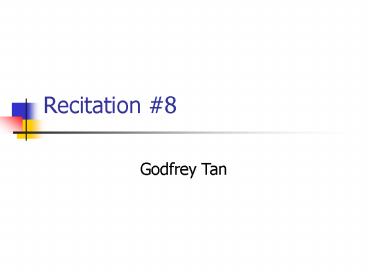Recitation - PowerPoint PPT Presentation
Title:
Recitation
Description:
Project to be posted right after Spring Break. PS3/4 Spec ... PS3/4 Rep Exposure. Class Graph { HashMap nodes; // key=node, ... PS3/4 Object Models. Problem OM ... – PowerPoint PPT presentation
Number of Views:271
Avg rating:3.0/5.0
Title: Recitation
1
Recitation 8
- Godfrey Tan
2
Administrivia
- Please be succinct in your answers!
- PS5 due next Tuesday
- PS6 due Tuesday after Spring Break
- Form Project groups!
- 3-4 people
- Email me by next Tuesday
- Project to be posted right after Spring Break
3
PS3/4 Spec
- Never include implementation detail in the spec
for public interfaces - adds Edges to the HashMap
- Be specific.
- // removes edge connecting Nodes src and dst
- void removeEdge(Node src, Node dst)
4
PS3/4 Rep Exposure
- Class Graph
- HashMap nodes // keynode, valueedge list
- List getEdges(Node n)
- return (List) nodes.get(n) // die die
- List getEdges(Node n)
- return
- Collections.unmodifiableList((List)
nodes.get(n))
5
PS3/4 Object Models
- Problem OM
- NO implementation details indicate WHAT abstract
data are maintained - Sets reflect the abstract data (say Nodes and
Edges) - Draw by examining specifications
- Code OM
- Refinement of POM
- Indicate important implementation details about
HOW you maintain data (like Hashtable, ArrayList,
) - Draw by examining source code
6
Notions of Equivalence
- Behaviorally Equivalent
- If there is no sequence of (mutative) operations
that can distinguish them - Observationally Equivalent (similar)
- If no difference can be observed through observer
operations
7
Behaviorally Equivalent equals
- Mutable types
- Can only be equals to itself
- StringBuffer s new StringBuffer(thing)
- StringBuffer t new StringBuffer(thing)
- s.equals(t) ?
- Immutable types
- If all the fields in both objects are equals
- String a thing String b thing
- a.equals(b) ?
8
Observationally Equivalent similar
- Mutable types
- If all the fields in both objects are similar
- StringBuffer s new StringBuffer(thing)
- StringBuffer t new StringBuffer(thing)
- s.similar(t) ?
- Immutable types
- If all the fields in both objects are similar
- String a thing String b thing
- a.similar(b) ?
9
Implementation
- public class MyObject extends Object
- MyObject(boolean mutable)
- ismutable mutable
- boolean equals(Object other)
- if(ismutable)
- // ?
- else
- // ?
10
Implementation
- public class MyObject extends Object
- MyObject(boolean mutable)
- ismutable mutable
- boolean equals(Object other)
- if(ismutable)
- return super.equals(other)
- else
- return similar(other)
11
Implmentation
- public class MyObject
- boolean similar(Object other)
- // check whether each field is
- // similar by value and return the
- // conjunction () of the results.
12
Implementation
- public class MyObject extends Object
- MyObject(boolean mutable)
- ismutable mutable
- int hashCode()
- if(ismutable)
- // ?
- else
- // ?
13
Implementation
- public class MyObject extends Object
- MyObject(boolean mutable)
- ismutable mutable
- int hashCode()
- if(ismutable)
- return super.hashCode()
- else
- // sum of each fields hashcodes
14
Remember!
- a.equals(b) ?
- a.hashCode() b.hashCode()
- This must be satisfied even when all the fields
are primitive types
15
Weakest Precondition
- For each statement S with pre-assertion P
- Assume post-assertion Q is true
- (Substitute S in Q) wp(S,Q)
- Check P ? wp(S,Q)
- If false, we have trouble!
- Example
- Pre-assertion P y 0
- Code S x y 1
- Post-assertion Q x 1
16
Proof
- Example
- Pre-assertion P y 0
- Code S x y 1
- Post-assertion Q x 1
- Assume x 1
- Substitute x y 1
- y 1 1
- Check y 0 ? y 1 1
- TRUE
17
Loops P while b S Q
- Unrolled-loop analysis hard
- Solution find a loop invariant I s.t.
- Base Case P ? I
- For each iteration where b is true
- after b and S executed, I still holds
- When b is false, loop terminates
- I still true and Q is true
18
Example
- // remove all elements in the list equal
- // to the first element
- int i 1
- while(i
- if( list.get(i).equals(list.get(0)) )
- list.remove(i)
- else
- i
- What is the loop invariant?
19
Example
- // remove all elements in the list equal
- // to the first element
- int i 1
- while(i
- if( list.get(i).equals(list.get(0)) )
- list.remove(i)
- else
- i
- What is the loop invariant?
- for all 0 list 0
20
PS5
- Build a back-end for a Foliotracker application
and a test application - For PS6, you will have to build a front-end GUI
21
Components
- Portfolio
- Identified by name
- Contains stock positions
- Stock Position
- Identified by ticker symbol
- Contains of shares
- Price at which stock is bought (optional)
22
Requirements
- Must support multiple portfolios
- Data must be persistent
- Flexible so that a front-end application can use
your API easily - Get price for a stock
- polling vs callback vs on-demand
- Modifying Stock Positions (buy/sell)































